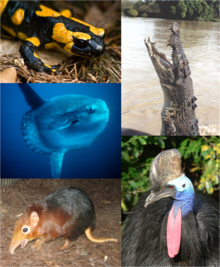
Back عظميات الفم الحقيقية Arabic Euteleòstoms Catalan Шăмăлла çурăм тунилли CV Euteleostomi German Euteleostomi Spanish مهرهداران استخوانی Persian Euteleostomi French בעלי עצם HE Euteleostomi Italian Euteleostomi Dutch
| Euteleostomes | |
|---|---|

| |
| Individual organisms from each major Euteleostomi group. Clockwise, starting from top left:
Fire salamander (Amphibia), saltwater crocodile (Reptilia), southern cassowary (Aves), black-and-rufous giant elephant shrew (Mammalia), ocean sunfish (Osteichthyes) | |
| Scientific classification | |
| Domain: | Eukaryota |
| Kingdom: | Animalia |
| Phylum: | Chordata |
| Clade: | Teleostomi |
| Clade: | Euteleostomi |
| Subgroups | |
Euteleostomi (Eu-teleostomi[a], where Eu- comes from Greek εὖ 'well, good'[b] or Euteleostomes, also known as "bony vertebrates"[c]) is a successful clade that includes more than 90% of the living species of vertebrates. Both its major subgroups are successful today: Actinopterygii includes most extant bony fish species, and Sarcopterygii includes the tetrapods.
Euteleostomes originally all had an endochondral bone, fins with lepidotrichs (fin rays), jaws lined by maxillary, premaxillary, and dentary bones composed of dermal bone, and lungs. Many of these characters have since been lost by descendant groups, however, such as lepidotrichs lost in tetrapods, and bone lost among the chondrostean fishes. Lungs have been retained in dipnoi (lungfish), and many tetrapods (birds, mammals, reptiles, and some amphibians). In many ray-finned fishes, lungs have evolved into swim bladders for regulating buoyancy, while in others they continue to be used as respiratory gas bladders.[5][6][7]
- ^ Zhao, W.; Zhang, X.; Jia, G.; Shen, Y.; Zhu, M. (2021). "The Silurian-Devonian boundary in East Yunnan (South China) and the minimum constraint for the lungfish-tetrapod split". Science China Earth Sciences. 64 (10): 1784–1797. Bibcode:2021ScChD..64.1784Z. doi:10.1007/s11430-020-9794-8. S2CID 236438229.
- ^ Berman, Jules (25 June 2004). Evolution's Clinical Guidebook. Oxford University Press. p. 215. ISBN 0-12-817127-8. Retrieved 14 May 2015.
- ^ Nelson, Joseph (2007). Fishes of the World. John Wiley & Sons. p. 86. ISBN 978-0-471-75644-6.
- ^ Cracraft, Joel; Donoghue, Michael J. (25 April 2019). Assembling the Tree of Life. Academic Press. p. 396. ISBN 978-0-19-972960-9.
- ^ Clack, Jennifer A. (27 June 2012). Gaining Ground, Second Edition: The Origin and Evolution of Tetrapods. Indiana University Press. pp. 21–4. ISBN 978-0-253-00537-3. Retrieved 12 May 2015.
- ^ Longo, Sarah; Riccio, Mark; McCune, Amy R (2013). "Homology of lungs and gas bladders: Insights from arterial vasculature". Journal of Morphology. 274 (6): 687–703. doi:10.1002/jmor.20128. ISSN 0362-2525. PMID 23378277. S2CID 29995935.
- ^ McCune, Amy R.; C. Schimenti, John (2012). "Using Genetic Networks and Homology to Understand the Evolution of Phenotypic Traits". Current Genomics. 13 (1): 74–84. doi:10.2174/138920212799034785. ISSN 1389-2029. PMC 3269019. PMID 22942677.
Cite error: There are <ref group=lower-alpha> tags or {{efn}} templates on this page, but the references will not show without a {{reflist|group=lower-alpha}} template or {{notelist}} template (see the help page).
Cite error: There are <ref group=note> tags on this page, but the references will not show without a {{reflist|group=note}} template (see the help page).
© MMXXIII Rich X Search. We shall prevail. All rights reserved. Rich X Search